Exhibit 99.1

| Goldman Sachs U.S. Financial Services Conference 2013 Andy Cecere Vice Chairman and CFO December 11, 2013 |
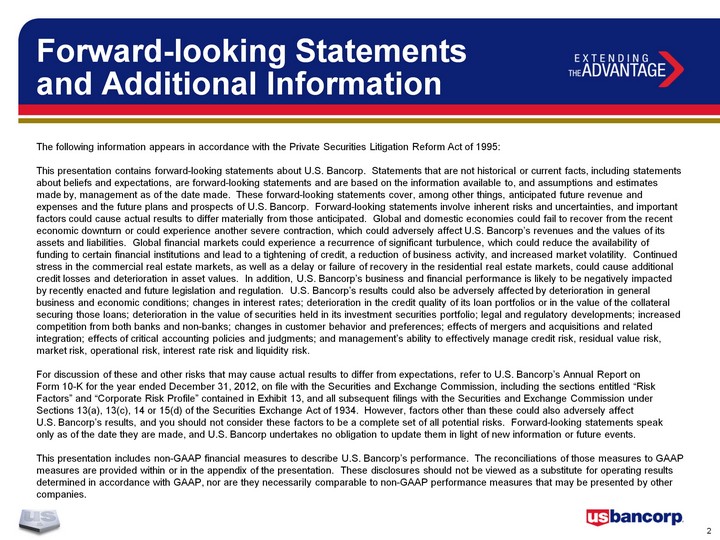
| Forward-looking Statements and Additional Information The following information appears in accordance with the Private Securities Litigation Reform Act of 1995: This presentation contains forward-looking statements about U.S. Bancorp. Statements that are not historical or current facts, including statements about beliefs and expectations, are forward-looking statements and are based on the information available to, and assumptions and estimates made by, management as of the date made. These forward-looking statements cover, among other things, anticipated future revenue and expenses and the future plans and prospects of U.S. Bancorp. Forward-looking statements involve inherent risks and uncertainties, and important factors could cause actual results to differ materially from those anticipated. Global and domestic economies could fail to recover from the recent economic downturn or could experience another severe contraction, which could adversely affect U.S. Bancorp's revenues and the values of its assets and liabilities. Global financial markets could experience a recurrence of significant turbulence, which could reduce the availability of funding to certain financial institutions and lead to a tightening of credit, a reduction of business activity, and increased market volatility. Continued stress in the commercial real estate markets, as well as a delay or failure of recovery in the residential real estate markets, could cause additional credit losses and deterioration in asset values. In addition, U.S. Bancorp's business and financial performance is likely to be negatively impacted by recently enacted and future legislation and regulation. U.S. Bancorp's results could also be adversely affected by deterioration in general business and economic conditions; changes in interest rates; deterioration in the credit quality of its loan portfolios or in the value of the collateral securing those loans; deterioration in the value of securities held in its investment securities portfolio; legal and regulatory developments; increased competition from both banks and non-banks; changes in customer behavior and preferences; effects of mergers and acquisitions and related integration; effects of critical accounting policies and judgments; and management's ability to effectively manage credit risk, residual value risk, market risk, operational risk, interest rate risk and liquidity risk. For discussion of these and other risks that may cause actual results to differ from expectations, refer to U.S. Bancorp's Annual Report on Form 10-K for the year ended December 31, 2012, on file with the Securities and Exchange Commission, including the sections entitled "Risk Factors" and "Corporate Risk Profile" contained in Exhibit 13, and all subsequent filings with the Securities and Exchange Commission under Sections 13(a), 13(c), 14 or 15(d) of the Securities Exchange Act of 1934. However, factors other than these could also adversely affect U.S. Bancorp's results, and you should not consider these factors to be a complete set of all potential risks. Forward-looking statements speak only as of the date they are made, and U.S. Bancorp undertakes no obligation to update them in light of new information or future events. This presentation includes non-GAAP financial measures to describe U.S. Bancorp's performance. The reconciliations of those measures to GAAP measures are provided within or in the appendix of the presentation. These disclosures should not be viewed as a substitute for operating results determined in accordance with GAAP, nor are they necessarily comparable to non-GAAP performance measures that may be presented by other companies. |
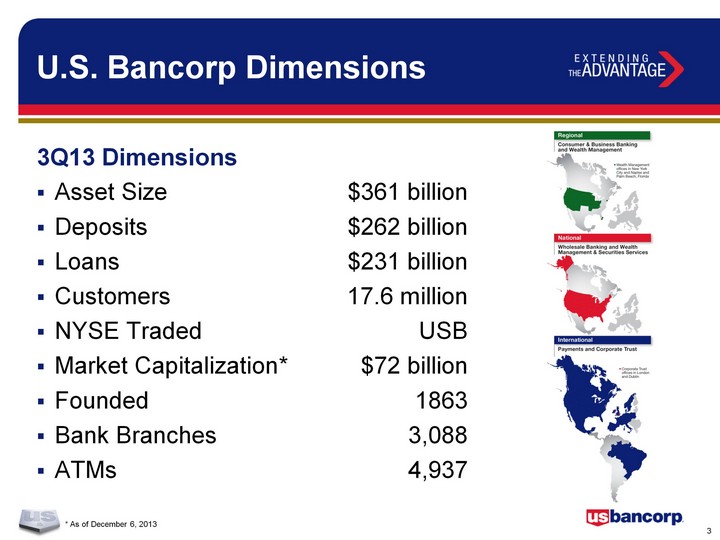
| U.S. Bancorp Dimensions * As of December 6, 2013 Asset Size $361 billion Deposits $262 billion Loans $231 billion Customers 17.6 million NYSE Traded USB Market Capitalization* $72 billion Founded 1863 Bank Branches 3,088 ATMs 4,937 3Q13 Dimensions |

| U.S. Bancorp Creating Shareholder Value Low Risk Above Market Growth Industry Leading Returns Capital Management Long-term Goals 4Q13 Update |
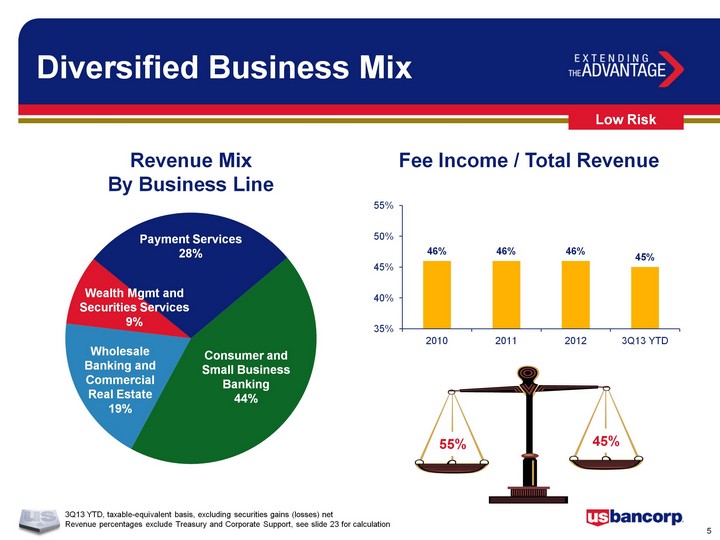
| Revenue Mix By Business Line (CHART) Consumer and Small Business Banking 44% Payment Services 28% Wealth Mgmt and Securities Services 9% Wholesale Banking and Commercial Real Estate 19% Fee Income / Total Revenue (CHART) 3Q13 YTD, taxable-equivalent basis, excluding securities gains (losses) net Revenue percentages exclude Treasury and Corporate Support, see slide 23 for calculation Diversified Business Mix 55% 45% Low Risk |
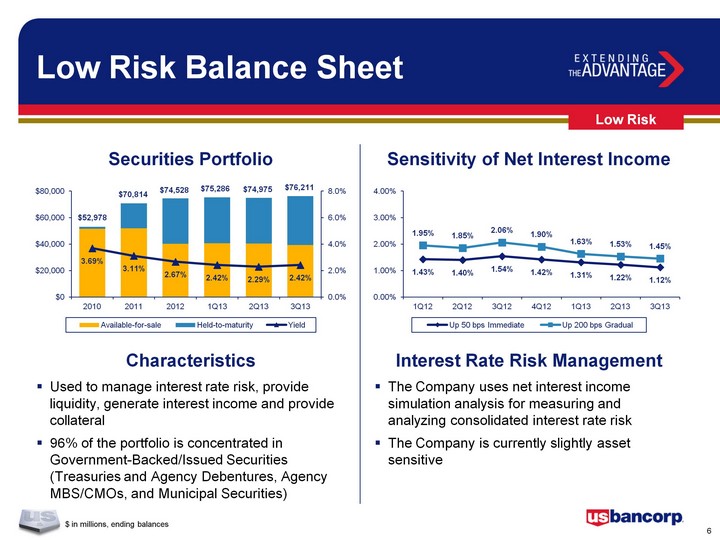
| $ in millions, ending balances Low Risk Balance Sheet Interest Rate Risk Management The Company uses net interest income simulation analysis for measuring and analyzing consolidated interest rate risk The Company is currently slightly asset sensitive Low Risk Used to manage interest rate risk, provide liquidity, generate interest income and provide collateral 96% of the portfolio is concentrated in Government-Backed/Issued Securities (Treasuries and Agency Debentures, Agency MBS/CMOs, and Municipal Securities) Securities Portfolio (CHART) $74,528 $75,286 $52,978 $70,814 $74,975 Characteristics Sensitivity of Net Interest Income (CHART) $76,211 |
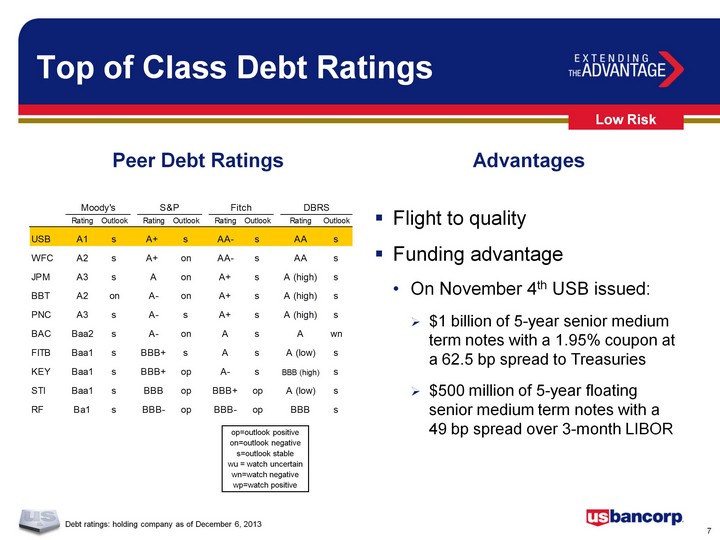
| Debt ratings: holding company as of December 6, 2013 Top of Class Debt Ratings op=outlook positive on=outlook negative s=outlook stable wu = watch uncertain wn=watch negative wp=watch positive Flight to quality Funding advantage On November 4th USB issued: $1 billion of 5-year senior medium term notes with a 1.95% coupon at a 62.5 bp spread to Treasuries $500 million of 5-year floating senior medium term notes with a 49 bp spread over 3-month LIBOR Advantages Peer Debt Ratings Low Risk |

| Growing Market Share Core Deposits 2.0% 2.6% Consumer Loans 1.8% 3.2% Mortgage Origination 0.7% 4.1% C&I Loans 3.2% 3.7% CRE Loans 1.6% 2.4% Source: SNL and Mortgagestats 3Q13 1Q07 USB Market Share Market Share Change Middle Market Loan 1.2% 7.0% Bookrunner Investment Grade Loan 0.3% 2.3% Bookrunner Investment Grade Bond NA 2.4% Bookrunner Source: Thomson Reuters and Securities Data Corp 2012 2007 USB Market Share Market Share Change 2012 2007 USB Market Share Market Share Change Credit Card (total volume) 4% 6% Fund Services (# of funds) 18% 24% Wealth Management (AUM) 1% 1% Source: Nilson (credit card), Visa and MasterCard issuers; Investment Company Institute (fund services); Barron's (wealth management), accounts over $5 million Municipal Trust 27% 31% Corporate Trust 7% 24% Structured Trust 16% 25% Source: Securities Data Corp based on number of issues 3Q13 YTD 2007 USB Market Share Market Share Change Growth |
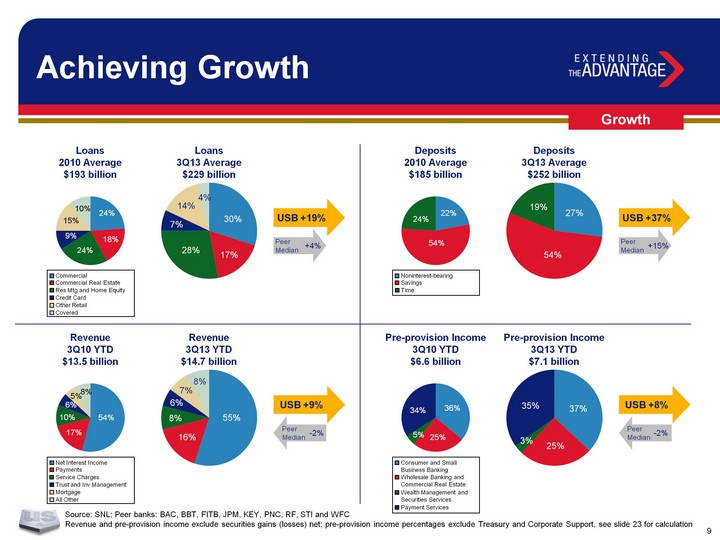
| Source: SNL; Peer banks: BAC, BBT, FITB, JPM, KEY, PNC, RF, STI and WFC Revenue and pre-provision income exclude securities gains (losses) net; pre-provision income percentages exclude Treasury and Corporate Support, see slide 23 for calculation Achieving Growth Growth (CHART) Loans 2010 Average $193 billion Loans 3Q13 Average $229 billion (CHART) Commercial Commercial Real Estate Res Mtg and Home Equity Credit Card Other Retail Covered Peer Median USB +19% +4% 24% 18% 24% 15% 10% 9% 30% 17% 28% 14% 4% 7% (CHART) Deposits 2010 Average $185 billion Deposits 3Q13 Average $252 billion (CHART) Noninterest-bearing Savings Time Peer Median USB +37% +15% 22% 54% 24% 27% 54% 19% (CHART) Revenue 3Q10 YTD $13.5 billion Revenue 3Q13 YTD $14.7 billion (CHART) Net Interest Income Payments Service Charges Trust and Inv Management Mortgage All Other USB +9% 54% 17% 10% 5% 8% 6% 55% 16% 8% 7% 8% 6% (CHART) Pre-provision Income 3Q10 YTD $6.6 billion Pre-provision Income 3Q13 YTD $7.1 billion (CHART) Consumer and Small Business Banking Wholesale Banking and Commercial Real Estate Wealth Management and Securities Services USB +8% 36% 25% 5% 34% 37% 25% 3% 35% Payment Services Peer Median -2% Peer Median -2% |

| Industry Leading Returns Return on Average Assets Return on Average Common Equity Efficiency Ratio Full Year 2012 3Q13 YTD (CHART) (CHART) (CHART) (CHART) (CHART) (CHART) Source: SNL and company reports Peer banks: BAC, BBT, FITB, JPM, KEY, PNC, RF, STI and WFC High Return |

| High Returns on Capital 2012 Return on Average Tangible Common Equity Source: SNL and company reports Peer banks: BAC, BBT, FITB, JPM, KEY, PNC, RF, STI and WFC (CHART) High return / capital efficient businesses Corporate Trust Merchant Processing Fund Services Treasury Management Corporate Payments Efficient expense platform Disciplined capital allocation process High Return |
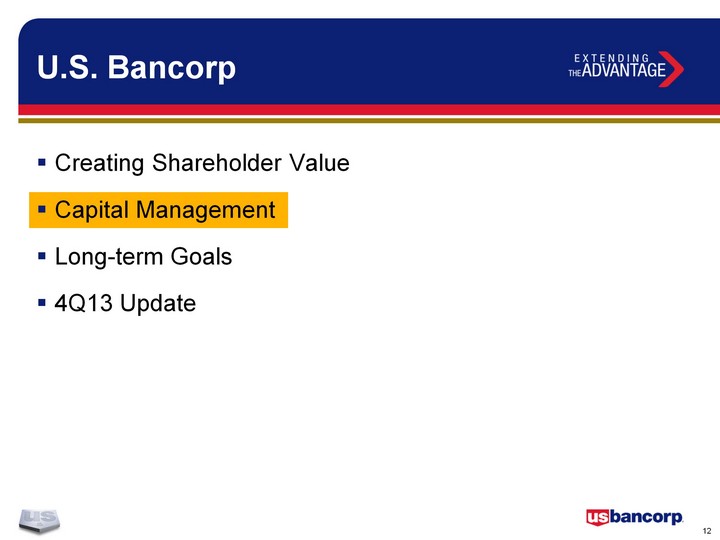
| U.S. Bancorp Creating Shareholder Value Capital Management Long-term Goals 4Q13 Update |
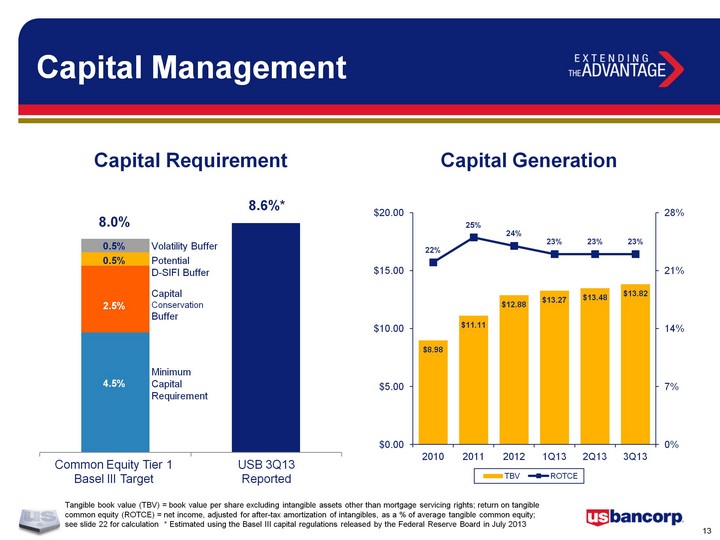
| Capital Management Capital Requirement Tangible book value (TBV) = book value per share excluding intangible assets other than mortgage servicing rights; return on tangible common equity (ROTCE) = net income, adjusted for after-tax amortization of intangibles, as a % of average tangible common equity; see slide 22 for calculation * Estimated using the Basel III capital regulations released by the Federal Reserve Board in July 2013 Capital Generation (CHART) 8.0% 0.5% Volatility Buffer 0.5% Potential D-SIFI Buffer 2.5% Capital Conservation Buffer 4.5% Minimum Capital Requirement 8.6%* Common Equity Tier 1 Basel III Target USB 3Q13 Reported |
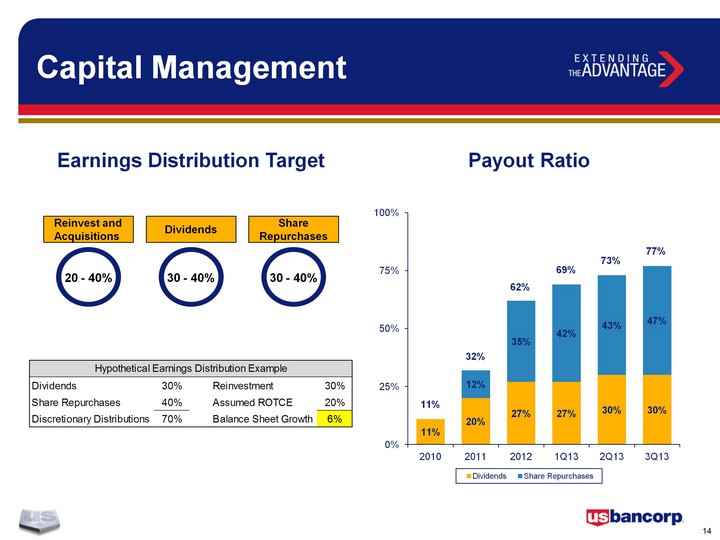
| Capital Management Earnings Distribution Target (CHART) 62% 69% 11% 32% 73% Reinvest and Acquisitions Dividends Share Repurchases 20 - 40% 30 - 40% 30 - 40% Payout Ratio 77% |
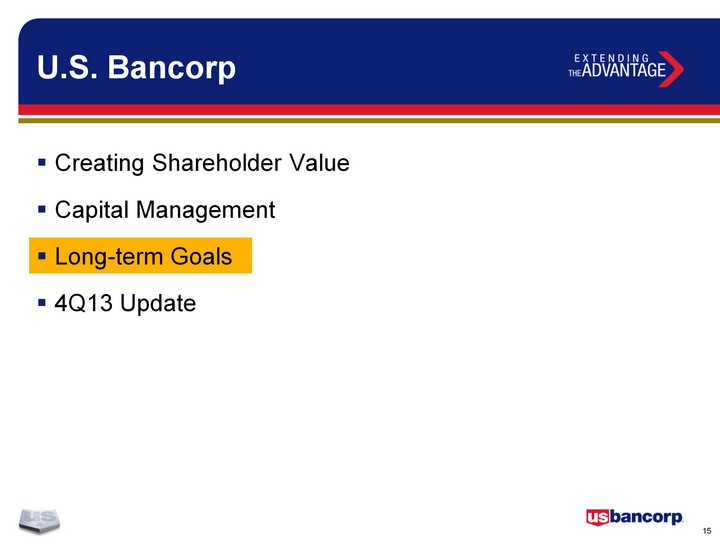
| U.S. Bancorp Creating Shareholder Value Capital Management Long-term Goals 4Q13 Update |

| Long-term Goals Long-term Goals Optimal business line mix Investments generating positive returns Profitability: ROE 16-19% ROA 1.60-1.90% Efficiency Ratio low 50s Capital distributions: Earnings distribution 60-80% Current Status Four simple and stable business lines Mortgage, wealth management, corporate banking, international payments, branch technology, internet and mobile channels, and select acquisitions 3Q13 YTD Profitability: ROE 16.0% ROA 1.67% Efficiency Ratio 51.6% 3Q13 Capital distributions: Distributed 77% of earnings (dividends 30%, share repurchases 47%) |
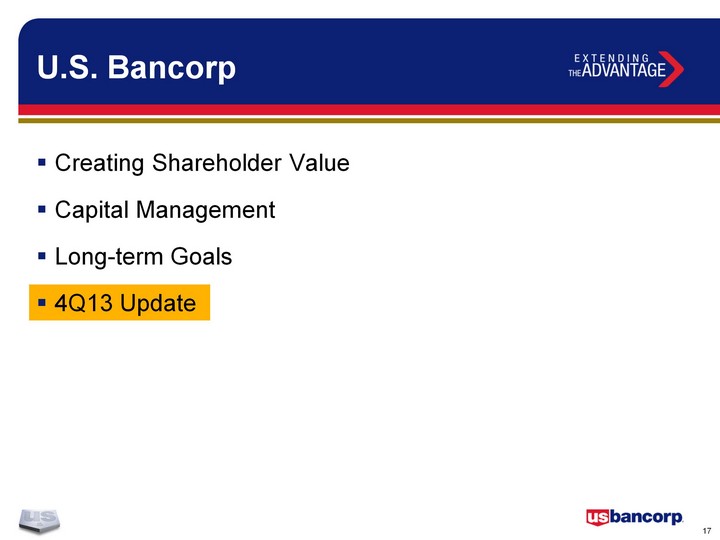
| U.S. Bancorp Creating Shareholder Value Capital Management Long-term Goals 4Q13 Update |
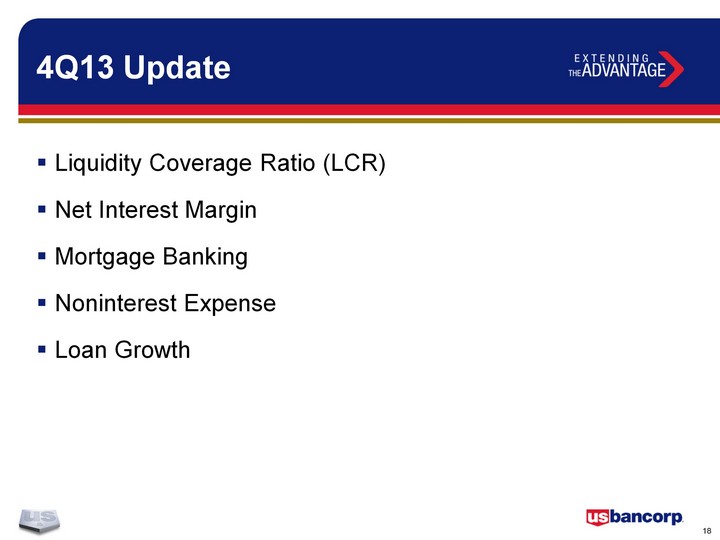
| 4Q13 Update Liquidity Coverage Ratio (LCR) Net Interest Margin Mortgage Banking Noninterest Expense Loan Growth |
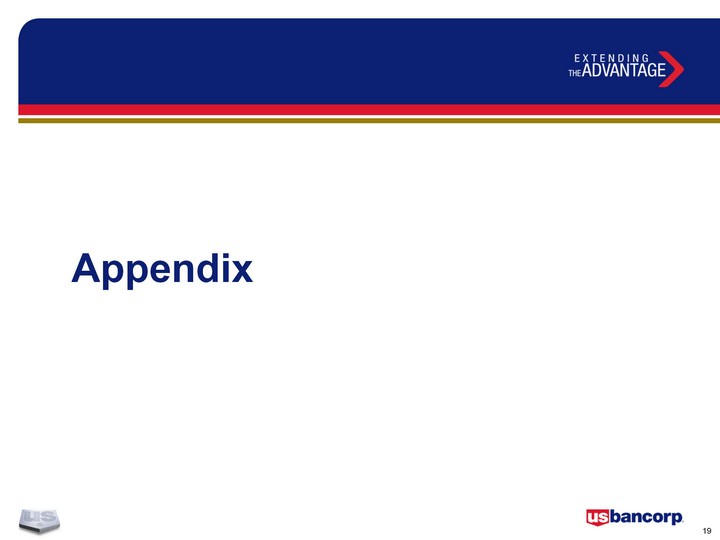
| Appendix |
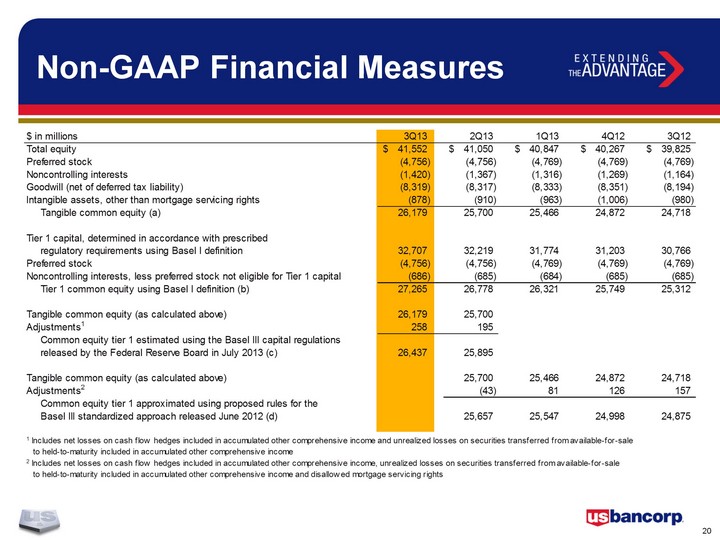
| Non-GAAP Financial Measures |
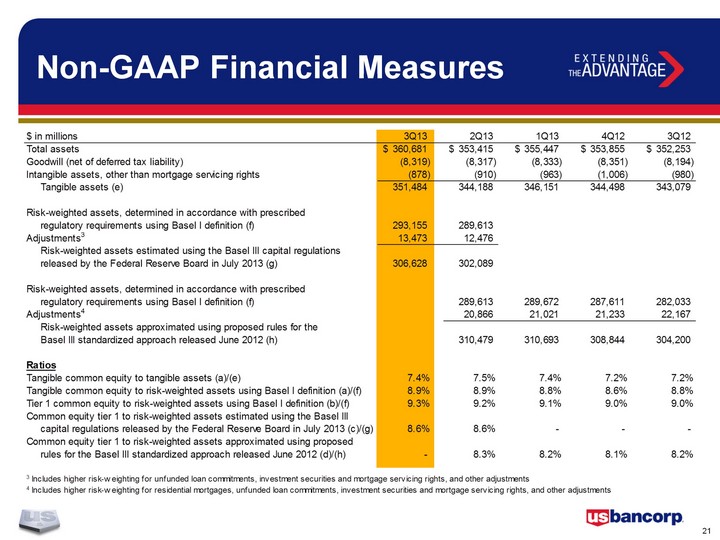
| Non-GAAP Financial Measures |
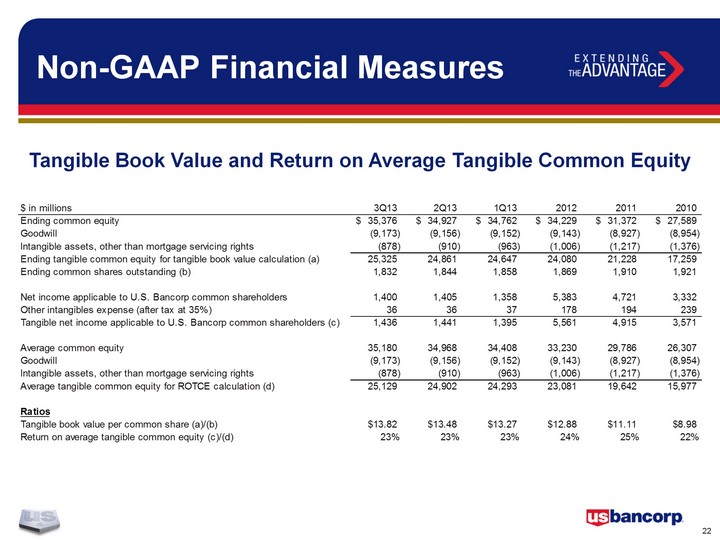
| Non-GAAP Financial Measures Tangible Book Value and Return on Average Tangible Common Equity |
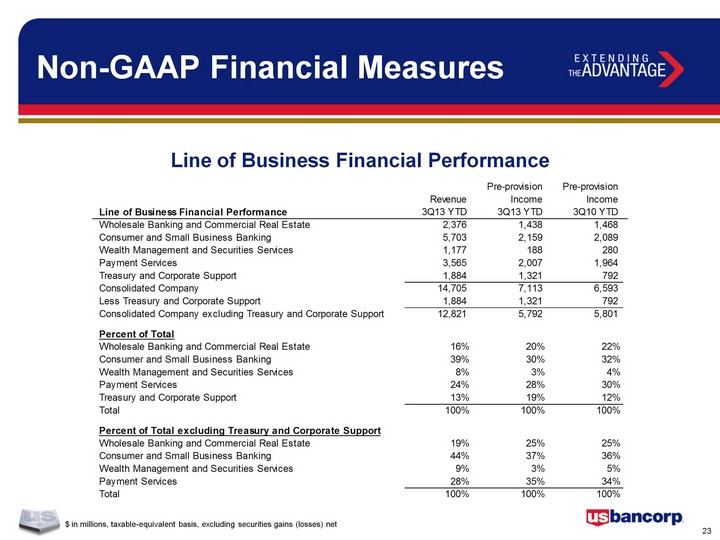
| Non-GAAP Financial Measures Line of Business Financial Performance $ in millions, taxable-equivalent basis, excluding securities gains (losses) net |

| Goldman Sachs U.S. Financial Services Conference 2013 |